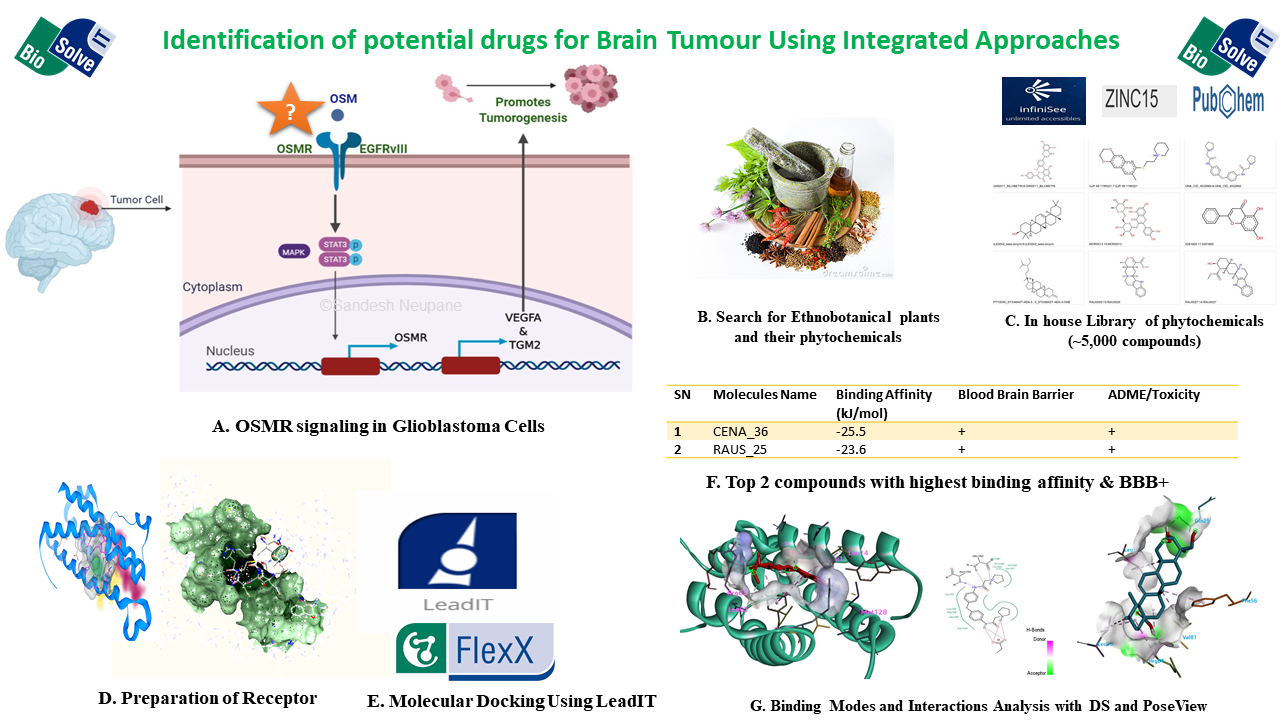Glioblastoma, also known as glioblastoma multiforme (GMB) is a highly lethal brain tumor particularly devastating among the cancers in the brain with less than two years of median survival rate of the patients. The existing treatment including surgical removal, radiation therapy, and chemotherapy are not efficient for the cure of the GMB, hence, there is an urgent need for better treatment of this devastating malignant glioblastoma. The cytokine receptor oncostatin-M receptor (OSMR) is a critical co-receptor of EGFRvIII (epidermal growth factor receptor variantIII). This demonstrates that EGFRvIII and OSMR, which itself is controlled by signal transducer and activator of transcription 3 (STAT3), physically interact to activate STAT3, inducing the proliferation, migration, invasion of the tumor, hence, promoting GBM formation. We hypothesized that inhibiting this signaling pathway by a small drug-like compound might impede GMB formation. To shut down this signaling pathway, we have integrated traditional ethnobotanical knowledge with a modern in silico drug design approach. Initially, we prepared the in-house database of 5,000 molecules including bioactives from plants which are traditionally used to treat different diseases related to cancer and bioactives from plants with central nervous system (CNS) stimulant activity. This was followed by docking in the binding pocket of OSM protein that interacts with OSMR. The binding pocket was determined using SeeSAR and the docking was done using FlexX in LeadIT. Ten compounds with the highest binding affinities were selected to assess their pharmacokinetic profiles (ADME/Tox) including the blood-brain barrier using admetSAR. Among 10 compounds, two compounds (code: CENA_36 & RAUS_25) were selected as potential anti-cancerous, based on their interaction and pharmacokinetic profiles. PoseView was used to analyze the binding mode and interaction of the compounds with the proteins. BioSolveIT software guided us on the way of potential drug discovery of this debilitating disease. The identified potential anti-cancerous compounds efficacies will be assayed on the glioblastoma cell line U-87 MG and cytotoxicities will be measured using a MTT assay followed by cell cycle analysis. These compounds from ethnobotanical plants are non-toxic, might easily penetrate the blood-brain barrier and could interact with OSMR, interfering with the signal transduction pathway which is involved in massive growth and suppression of apoptosis.
After 1 year, Sandesh has achieved the following goals:
- Preparation of the in-house virtual library of the phytochemicals. The plants and herbs that are traditionally used to treat cancer and different diseases related to the central nervous system were searched in literature and different traditional medicinal databases. The 3D structures of phytochemicals present in these plants were retrieved from different databases like phytochemical and ethnobotanical databases, PubChem and ChemSpider. Further, different online freely available databases containing the phytochemicals from the ZINC database were added to make approximately 5,000 molecules in our in-house database.
- Receptor preparation and molecular docking of OSM. The 3D structure of the human OSM protein was retrieved from protein data bank and the water molecules were deleted using SeeSAR. The binding pocket was also determined using SeeSAR. The 3D structure phytochemicals from the in-house library were docked against OSMR using FlexX in LeadIT. The top 10 molecules with the highest binding affinities were selected for pharmacokinetic analysis. The binding modes and interactions were analyzed using PoseView and Discovery Studio. Both identified compounds form interactions with the residues of the binding pocket of the proteins.
- In silico prediction of pharmacokinetic profiles (ADME/Toxicity). The pharmacokinetics (ADME/Tox) including blood-brain barriers of the top 10 potential anti-cancerous compounds were predicted using the online software admetSAR. The compounds that are predicted to be BBB positive, non-CYP450 substrates and non-CYP450-inhibitors, that are renal clearance positive, non-carcinogenic and non-environmental toxic were selected for further in vitro analysis. The major problem with current potential drugs is that they are derivatives of hydroxamic acid, which is lethal in high doses. In our research we focused on ethnobotanical plants which are generally used for treating cancers and CNS related diseases. Since these medicinal plants are usually non-toxic to human health, we may solve the problem arise due to toxic medicines. However, in vitro and in vivo tests are needed for evaluating the efficacies of these compounds.





